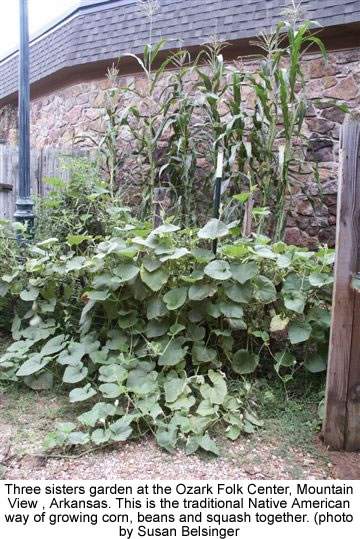 |
Canku Ota
|
 |
|
(Many Paths)
|
||
|
An Online Newsletter
Celebrating Native America
|
||
|
April 2014 - Volume
12 Number 4
|
||
|
|
||
|
The Beginning Of
North American Agriculture
|
||
|
by Joseph Rael Jr. -
Southern Ute Drum
|
||
|
Three of these occurred in South America, where chile peppers, squash, beans, yucca, yams and white and sweet potatoes were grown. North America’s contributions included squash, maize (corn) and beans – the trifecta of New World foods – as well as other species such as chile peppers and sunflowers, the seeds of which were consumed. Until the last few decades, some researchers thought that North American agriculture developed in Mexico approximately 5,000 years ago, whereas wheat and barley were domesticated in the Near East around 10,000 years ago. Recent discoveries, however, have dramatically changed the North American dates while identifying new regions where early domestication took place. The transition from nomadic hunting-and-foraging cultures to settled societies occurred in different places around the world at different times, but researchers now agree that New World agriculture started 10,000 years ago. Dolores Piperno of the Smithsonian Institution says that agriculture began in southwest Mexico. Around 8,000 B.C., the cold, arid climate became warmer and wetter as atmospheric carbon dioxide levels rose. In Mesoamerica, lowlands and tropical forests expanded, lakes filled with water, and new plant and animal species replaced old ones. People planted on these lake shores. In 1997, Smithsonian archaeologist Bruce Smith dated the seeds of a domesticated pepo (pumpkin) squash found in a cave in Oaxaca, Mexico, to nearly 10,000 B.C., which to date is North America’s oldest known domesticated plant. Phytoliths – fossilized mineral particles left by plants – from squash and arrow root indicate that these plants were being grown in Panama 9,000 years ago. Maize was one of the New World’s earliest crops, as well as one of its most important. A domesticated form of the wild grass teosinte maize is rich in carbohydrates. It’s easy to store and can be ground into flour to make different foods. Maize remained in dry caves in the semi-arid highland dating to 5,000 years ago. They assumed that was the beginning of maize or corn domestication. In fact, farmers were planting maize earlier elsewhere. Mary Pohl and Kevin Pope discovered evidence that farmers cleared forests, most likely for fields, 7,000 years ago. |
|
|
||
|
|
||
| Canku Ota is a free Newsletter celebrating Native America, its traditions and accomplishments . We do not provide subscriber or visitor names to anyone. Some articles presented in Canku Ota may contain copyright material. We have received appropriate permissions for republishing any articles. Material appearing here is distributed without profit or monetary gain to those who have expressed an interest. This is in accordance with Title 17 U.S.C. Section 107. | ||
|
Canku Ota is a copyright ©
2000 - 2014 of Vicki Williams Barry and Paul Barry.
|
||
 |
 |
|
|
The "Canku
Ota - A Newsletter Celebrating Native America" web site and
its design is the
|
||
|
Copyright ©
1999 - 2014 of Paul C. Barry.
|
||
|
All Rights Reserved.
|
||
 Of
the 10 historically recognized independent centers of plant domestication
worldwide, five were in the Americas.
Of
the 10 historically recognized independent centers of plant domestication
worldwide, five were in the Americas.